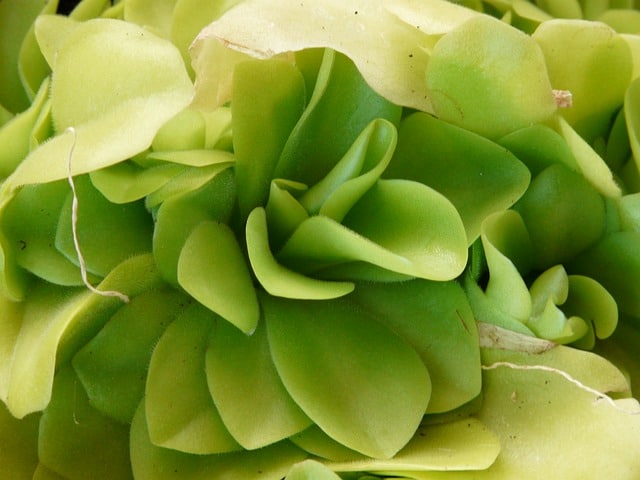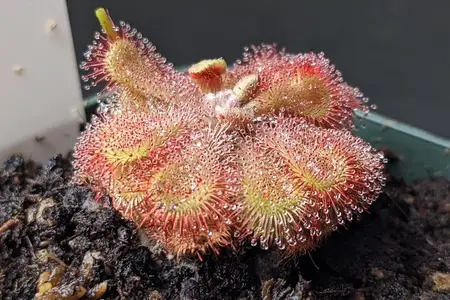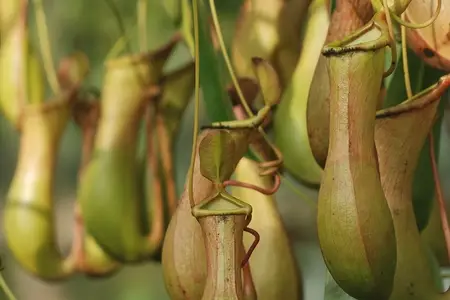Having pests at home is very annoying and finding a solution is not always obvious. When fruit flies become a problem, some people recommend employing Venus flytraps to control the bug population. I own many types of carnivorous plants, and in this article, I will share how effective each plant is in controlling fruit flies.
Venus flytraps consume fruit flies, but they are not an effective pest control for this type of insect. Most mature Venus flytraps are too big to capture fruit flies effectively. Other carnivorous plants offer a better solution to control fruit flies, gnats, and other small insects.
Now, let’s explore the best options to control a bug infestation at home.
Venus Fly Trap as Pest Control
Venus flytraps consume a wide array of insects. They eat flies and many other bugs, such as ants, gnats, worms, and spiders.
Venus flytraps are not effective bug controllers (especially for fruit flies) due to their size and their limited number of leaves. However, other carnivorous plants, such as Sundews, Pitcher plants, and Butterworts, are more effective at pest control.
Main Challenges
- Small insects such as ants, fruit flies, and gnats can escape from inside the traps of Venus flytrap leaves.
- Each Venus flytrap only grows up to about 10 traps, so it can only capture a very small number of insects at a time
- The digestion process for Venus flytraps can take more than a week or two. Traps remain closed and inactive for many days after trapping an insect.
- Venus flytraps require a dormancy period. During the winter they go into a dormant state and lose most of their leaves. During dormancy, they are not active predators.
You can still employ Venus flytraps to control your bug population at home, but you must remember that they can only consume a handful of insects every month. I grow Venus flytraps because I love them as plants, and their predatory nature is only a plus.
The Best Carnivorous Plants to Control Fruit Flies
These four types of carnivorous plants are very effective at controlling pests:
- Mexican butterworts
- Sundews (Drosera)
- Nepenthes pitcher pant
- Sarracenia
Now, let’s explore each of the options:

Mexican Butterworts
A type of carnivorous plant that can easily lure insects because of the sticky substance found in their leaves.
These carnivorous plants produce adhesive leaves that characterize by having a shiny glare. Insects become attracted by the leaves, and as soon as they land on the plant, they become stuck.
They are often found in humid regions that are mountainous, such as Central America and South America, and Mexico.
Butterworts are very effective at capturing flying insects, especially tiny ones, such as fruit fruitflies.
Pros:
- Butterworts can be grown indoors
- Depending on the climate, they can be grown indoors or outdoors and do not require a temperature change to experience dormancy.
- They can capture tons of tiny insects
Cons:
- Butterworsts are harder to find plants. However, some online nurseries do sell them.

Sundews
Sundews or Drosera have tentacles in their leaves that secrete adhesive substances to capture prey.
There are dozens of different Sundews out there. I recommend researching the specific variety before purchasing. Some sundews can be grown indoors, while others require full sun. Also, each type of Sundew has different requirements in terms of temperature and dormancy (not all Sundews need dormancy).
Some sundews like the Cape Sundew or Drosera Natalesis are very easy to care for. You can buy Cape Sundews online for an affordable price. Here is a link to a shop.
Pros:
- Sundews are easy to grow compared to other carnivorous plants
- Several varieties of sundews can be grown indoors
- Some varieties of Drosera do not require dormancy
- An average adult Drosera plant can capture multiple insects in each leaf
Cons:
- They need insects to stay heathy. If they do not consume enough bugs they end up suffering.
- Depending on the variety they can be small in size, which limits their capacity to capture insects.
Sundews and Mexican Butterworst are effective bug controllers for small insects such as gnats, fruit flies, and mosquitoes in indoor and outdoor locations. Some varieties are more effective than others, but most adults can trap multiple insects in each of their sticky leaves.

Nepenthes Pitcher Plant
At the end of their leaves, Nepenthes have pitcher-like structures that serve to capture insects.
Nepenthes attracts bugs with sweet nectar on the edge of their pitchers. Insects come to the pitchers to consume the nectar, but they can slide inside the pitcher full of digestive enzymes if they walk too far. Once bugs fall inside the pitcher, it is tough to escape as most insects end up drowning in the digestive juices.
Nepenthes can capture multiple insects at a time. Depending on the plant’s size, a single pitcher can hold dozens of insects.
Pros:
- Pitcher plants can capture many insects at a time
- Due to their size, Pitcher plants are not limited to consume a specific size or type of insect.
Cons:
- Under less than optimal conditions, pitcher plants can stop roducing pitcher and lose the bug trapping power
Sarracenia
The leaves of Sarracenia plants are tall pitcher-like structures that capture insects.
They attract bugs with sweet nectar and consume prey with digestive juices inside their leaves.
Sarracenia can act as a pest controller in outdoor locations. Since Sarracenia plants require lots of sunlight, it is challenging to grow them indoors. I would not recommend employing them for indoor pests, as Sarracenia won’t live very long without the proper lighting.
Adult Sarracenia pitchers are very large and can hold dozens of insects.
Pros:
- Sarracenia can capture many insects at a time
- Due to the size if their pitchers, Sarracenias are not limited to consume a specific size or type of insect.
Cons:
- Sarracenia won’t help with indoor pests as they are extremely hard to grow indoors.
Sarracenia and Nepenthes plants are effective bugs controllers in outdoor locations. These plants can hold large amounts of insects in their pitchers. For tangible results, it is recommended to employ carnivorous plants with other pest control practices.
Carnivorous Plant Care
Owning a carnivorous plant is an enjoyable and unique experience. However, keeping them alive and healthy can be a challenge for novice growers.
Carnivorous plants require specific care consideration to live. Here is a list of the most important aspects of growing carnivorous plants:
Watering
Carnivorous plants require water that contains very low mineral content. Most tap water and bottled water is unsuitable for carnivorous plants. Such water can cause mineral burns and eventually kill the plant.
Only water carnivorous plants with reverse osmosis water, distilled water, or rainwater.
The watering frequency for each type of carnivorous plant varies. However, most of them will require frequent watering.
Venus flytraps are often kept in a tray sitting in water to ensure the soil stays humid. Sundews require more water and are commonly placed in waterlogged conditions.
Soil
Carnivorous plants are intolerant to the minerals, additives, and fertilizers present in most soil blends. Never employ MiracleGro, succulent soil, cactus soil, or any standard potting soil.
You should only pot carnivorous plants in carnivorous plants soil. You can make carnivorous plant soil by buying the ingredients and combining them or by it online.
Each variety of carnivorous plant might benefit from a slightly different mix. However, most carnivorous plants blends include peat moss, long fiber sphagnum moss, perlite, or sand.
You can find more information about soil and where to buy it in this guide: Soil Guide.
Lighting
Proper lighting is a critical aspect of carnivorous plants. The vast majority thrives under very sunny and bright conditions. Some plants grow best indoors under grow lights and other outdoors with sunlight.
Dormancy
Some carnivorous plants require a dormancy period. Dormancy is similar to hibernation. The plant “rests” for a few months as it loses most of its leaves. After dormancy, they reflourish stronger than ever.
Make sure to research the dormancy requirement of your plant. Dormancy is an essential part of the plant’s development. Skipping dormancy or providing improper care during such a period can end up harming the plant.
Feeding
Outdoor carnivorous plants capture bugs on their own. Indoor plants need to be fed at least once a month to supplement their diet.
Even though carnivorous plants do not NEED to consume insects to survive, they benefit significantly from the extra nutrients.
This section covered a general overview of carnivorous plants care. However, there is a lot more to cover. In this article, I cover a complete guide to Carnivorous Plant Care.
Pest Control Solutions to Eliminate Fruit Flies
1. Use fruit flies traps.

This option is a chemical-free solution. The traps are straightforward to use and effective.
The process is simple. Add a bait inside the plastic trap and wait until the gnats and fruit flies enter. Once they enter, they are unable to escape.
I have seen disposable options in the grocery store, but personally, I prefer the reusable kind. You can buy a set of reusable fruit flies traps online and start reducing your fruit fly infestation. Here is a link to a good option you can find on Amazon.com.
2. Use a Fruit fly spray eliminator.
Many brands offer multi-purpose bug-eliminating sprays and some specific to fruit flies and gnats. Consider using one of these solutions from the grocery or hardware store.
3. Sanitize the area.
This tip won’t only help you eliminate fruit flies but also prevent future infestations.
Make sure to wipe counters and surfaces where fruit flies linger. Eliminate any organic residue to stop attracting bugs.
4. Use a food net to isolate insects from your meal.

Use a mesh-type food net to keep the food attracting fruit flies away from the infestation. Also, to avoid luring more insects, make sure to toss any fruit or other food that might be rotting or close to spoiling.
5. Store all or at least most food in the fridge.
Not all food needs to be kept in the fridge. But, if you have a bug infestation, you might want to consider maintaining food products out of reach by placing them inside the refrigerator.

